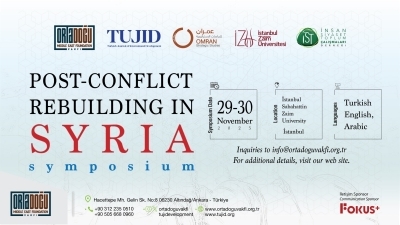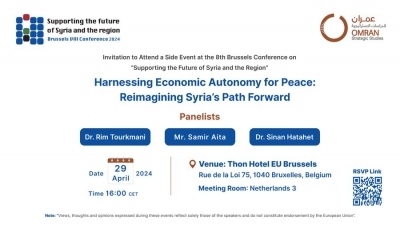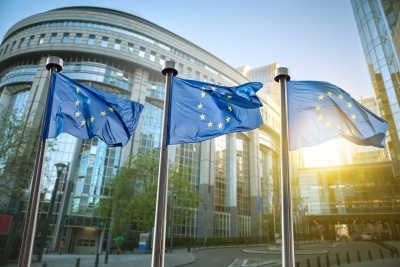Executive Summary
- During the first half of 2022, 358 projects were implemented in Northeast Syria region. The water and sanitation sector topped the list with 148 projects, followed by transportation 77 projects, electricity 51 projects, social services 34 projects, trade 23 projects, and agriculture and livestock 18 projects. The distribution of the projects according to the administrative districts included the following: al-Jazeera Region 118 projects, Deir ez-Zor Region 96 projects, Raqqa Region 58 projects, Tabqa Region 41 projects, the Euphrates Region 29 projects, and Manbij Region 19 projects.
- Several administrative decisions by local authorities were issued during the monitoring period of this report. This included a decision banning the transport of wheat within the Autonomous Administration's regions without an official authorization letter issued by the “Administration”, fixing wheat prices at 2.200 SYP/Kg, limiting the quantity of diesel allocated per household to 300 liters/month at a price of 150 SYP/liter, and granting 100,000 SYP to every public employee in the region.
- The areas under the control of the Autonomous Administration suffer from severe crises in all sectors, which has led to the increase of monopolies, spread of corruption, and lack of a defensive ability to address crises imported from the regime's areas. This indicates a structural deficiency in the socio-economic model adopted and a governance inefficiency of the concerned institutions(1)
I. Methodology
The Autonomous Administration region of North and East Syria (AANES) encompasses parts of the governorates of Hasaka, Raqqa, and Deir ez-Zor. It extends over 50.000 square kilometers and hosts approximately 3.2 million inhabitants.
Under the Charter of Social Contract adopted by the AANES, the region consists of seven self-governing sub-regions: al-Jazeera, Deir ez-Zor, Raqqa, Tabqa, the Euphrates (al-Furat), Manbij, and Afrin.
The objective of the early economic recovery report is to provide a comprehensive analysis of the activities of municipalities as well as foreign and local organizations in the region during the first half of 2022. By compiling other recovery reports from the opposition and regime areas, the combined reports seek to assess and investigate the following:
- Activities and projects implemented, the development of local economies, and the comparison of regions and sectors.
- Levels of a safe working environment that governing entities and decision-makers can create to increase job opportunities, business and production operations, and local demand.
- Legislation and administrative decisions and their impact on the local economy.
This report attempts to monitor and analyze the implementation of economic and development projects in various sectors. Accordingly, it induces decision-makers to direct the support and fill gaps wisely. Based on the updated administrative division of the region and according to the International Standard Industrial Classification, the report focused on main cities and towns with notable economic activity.
The report represents actual activities that took place based on public source information available as well as individual interviews conducted by field staff. It does not claim to reflect all activities that took place but those that were announced publicly. It monitored and assessed data from official social media accounts of municipalities and organizations that operate in the area by documenting their activities and public periodic reports, and utilizing specified monitoring criteria that enabled data analysis based on sectoral and geographical classifications.

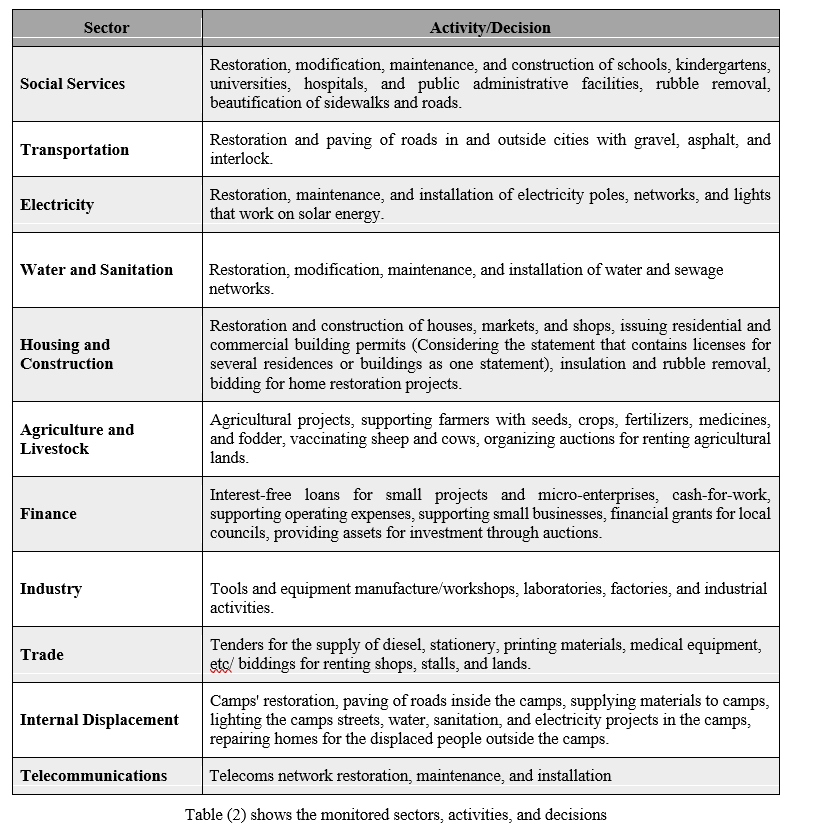
II. Economic Recovery Indicators: Weak Strategies & Will
As indicated in Figure (1), the number of projects implemented in the various districts of the AANES was 358. As for the distribution of projects’ percentages, the water and sanitation sector topped the list with 148 projects (40%), followed by the transportation sector with 77 projects (21%). The electricity sector was ranked three with 51 projects (14%), and the social services sector came in fourth place with 34 projects (9%), as shown in Figure (2).
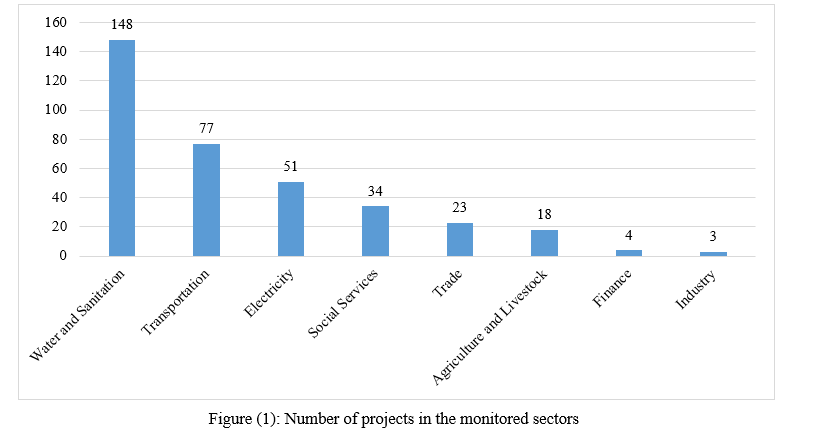
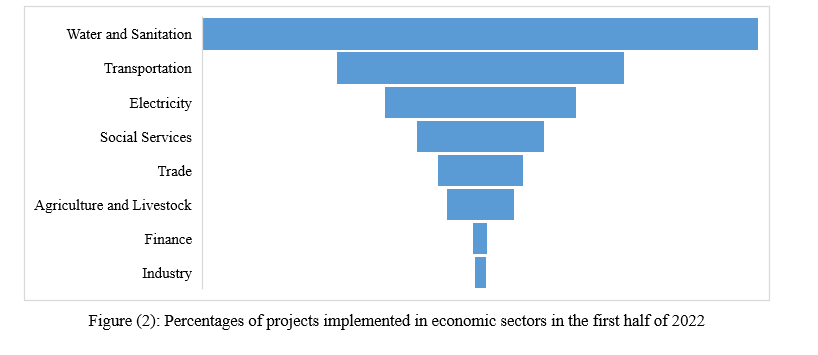
According to the geographical distribution of the monitored area, the largest percentage of projects was implemented in the al-Jazeera region 118 projects, followed by the Deir ez-Zor region 96 projects, Raqqa region 58 projects, Tabqa region 41 projects, Euphrates region 29 projects, and Manbij region 19 projects.
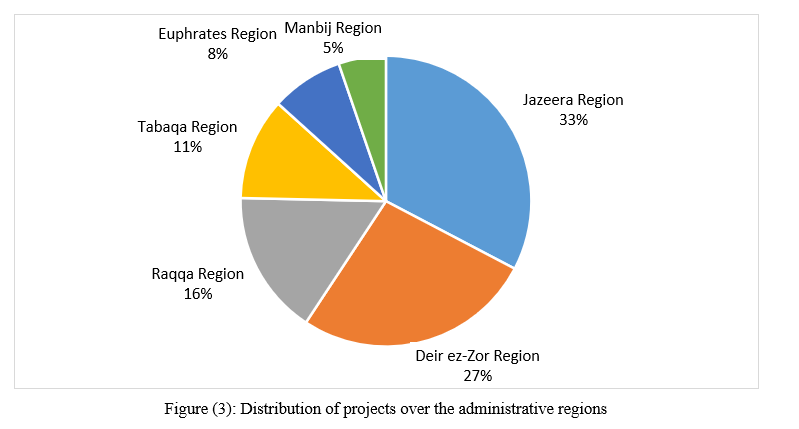
More specifically, Figure (4) displays the distribution of projects in the cities and towns monitored in all sectors. Markedly, Raqqa city ranked first with 58 projects, followed by the cities of al-Tabqa with 41 projects, Hajin with 34 projects, al-Qamishli with 26 projects, al-Busayrah with 23 projects, and Manbij with 19 projects.
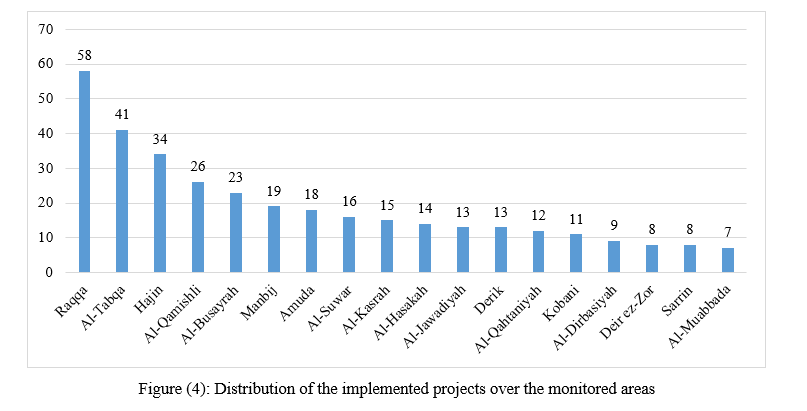 Water and Sanitation Sector
Water and Sanitation Sector
Out of 148 projects carried out, al-Tabqa city took the lead with 21 projects, followed by the cities of Hajin 18 projects and al-Busayrah14 projects, as shown in Figure (5). The projects included the installation of drinking water pipelines, with a length of 4000 meters, in the villages of Sarrin, Quroshan, and al-Murabba. There were also two other pipelines constructed: the first from the city of al-Busayrah to the reservoir of the village of al-Tukaihi (5,500 meters) and the second in the village of Abu al-Hassan (850 meters).
Other projects included expanding the water pipelines by 1150 meters in Hoti village, restoration of the water networks in the Kasra sub-district and al-Muhamida water station and establishing a new water station in al-Baghuz. However, the region suffers from several problems, the most significant of which is the lack of drinking water in the governorates of al-Hasakah, Deir ez-Zor, and Raqqa. For example, al-Hasakah city, which is inhabited by about a million people, suffers from constant water cuts caused by field disputes with the opposition factions in Ras al-Ayn, where Alouk water station operates.
The Alouk station delivers water to al-Hasakah at the rate of 60,000 m3/day, but the administration’s deliberate power cut disturbs its running. Russia has mediated between the two parties several times but all in vain. To compensate, the “administration” ran 16 desalination plants and transported water to homes through road tankers.
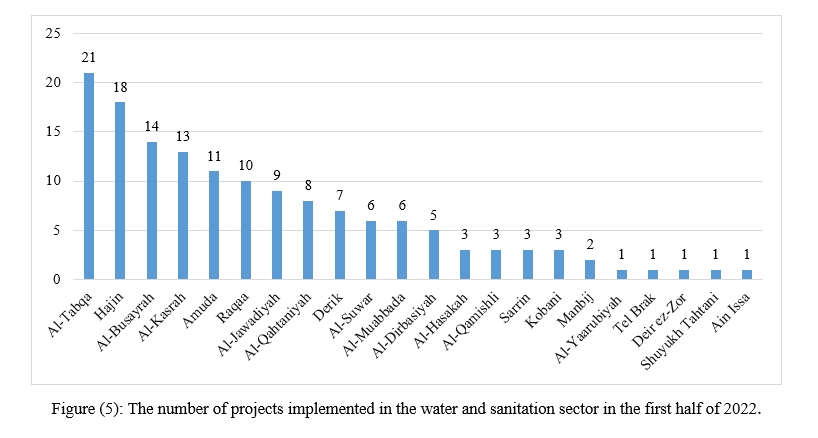 Transportation Sector
Transportation Sector
Seventy-seven projects were carried out in the transportation sector by municipalities and different organizations, with the cities of Manbij, al-Tabqa, Raqqa, and al-Qamishli taking the top four ranks, respectively. There were many projects of paving roads and restoration that took place in different locations of the monitored region, and here are some examples:
- Paving the highway between al-Hasakah and al-Dirbasiyah (20 km)
- Paving the road of the village of al-Jawadiyah in the Derik area of al-Qamishli (9 Km)
- Paving the roads of the Corniche, al-Hilaliyah, and the Western neighborhood
- Paving the road of al-Suwar city (10 km) and the restoration of its bridge
- Paving the street of Abu Hardoub in al-Busayrah
- Paving the road connecting the village of Taan and al-Sayed, Tel Houdan road (500 meters), Shajif Zahabieh village road (12450 meters), and al-Fars Abu Qalqal road (8300 meters) in Manbij.
- Road restorations in the neighborhoods of al-Sabbahiya, al-Tayyar, al-Jazeera, and al-Rumaila in Raqqa
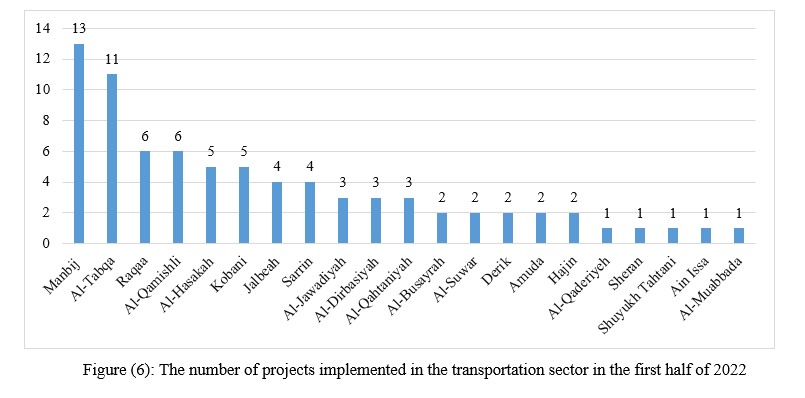 Electricity Sector
Electricity Sector
Fifty-one projects were implemented in the electricity sector, with al-Qamishli, Raqqa, and Hajin in the top three positions.
The works carried out varied to include the following:
- Installing a power transformer, five towers, and 13 wooden poles in Kobani
- Installing street lighting at the northern and southern entrances in Sarrin
- Installing street lighting in the towns and cities of al-Shaitat, al-Shaafa, Hajin, al-Baghouz, al-Suwar, Muhaimidah, al-Malahi, and the city of Raqqa
- Completing the project of the 7000 meters of lighting in the al-Nasrah neighborhood in al-Hasakah
- Installing 40 solar panels and four poles in several places in the city of al-Qamishli
- Installing new power transformers of 400 KVA and other ones with different capacities in many neighborhoods and villages
Nevertheless, people suffer from a chronic electricity shortage. In fact, they depend on the amperes, as the AANES provides diesel at a reduced price for neighborhood generators at 85 SYP per liter instead of 410 SYP.
The situation was exacerbated in al-Qamishli, with the “Administration” cutting off diesel from the generators that provide homes with electricity. In addition, many factories, industrial and commercial projects, and bakeries became out of work because the “Administration” blocked the diesel allocations assigned to the industrial and commercial sectors.
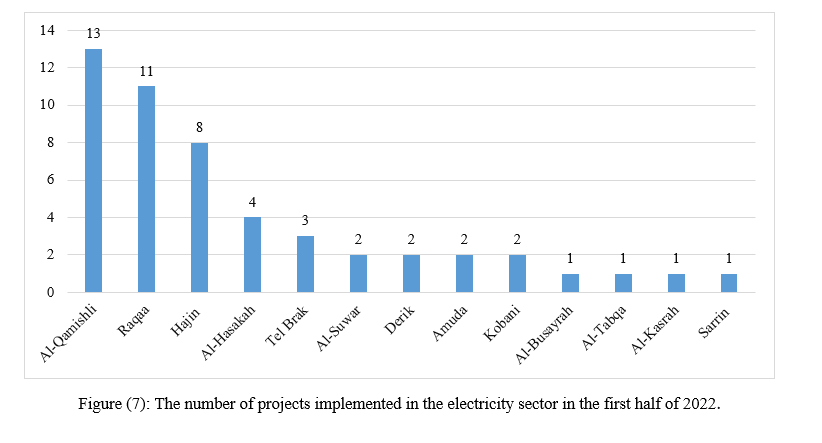 Social Service Sector
Social Service Sector
34 projects were implemented in al-Tabqa, Deir ez-Zor, and al-Busayrah, including rubble removal for the cities' streets. Other projects were also completed in the monitored towns and villages and included the following:
- Building al-Bayram School in Manbij
- Establishing an agricultural land reserve (12,000 m2) near the Borzi Dam
- Constructing a development center in al-Dirbasiyah at the cost of $4211
- Opening two new Newroz markets in the Western neighborhood of al-Qamishli
- Restoration of a number of municipalities such as al-Dahla, al-Za'bar, al-Hussein, Jadeed Ekedat, al-Keshkiyah, and al-Tabqa
Although the AANES’s vision is to serve the interests of society by establishing economic institutions that are social in nature, the number of projects in this sector does not correspond to its stated goal.
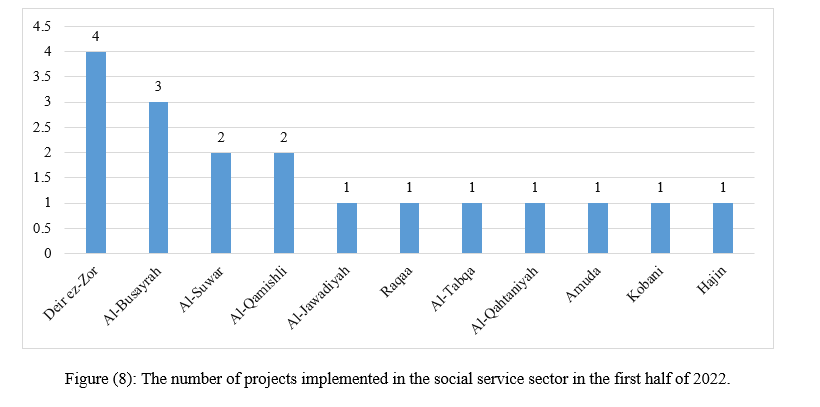 Trade Sector
Trade Sector
In the trade sector, 23 projects were implemented, with Raqqa coming in first with 15 projects. Other cities such as Hajin, al-Tabqa, Deir ez-Zor, and Manbij were also included in the list.
The projects included several commercial and economic activities and were as follows:
- Requesting price quotations for renting vehicles such as vans, tractors, and dump trucks
- Launching auctions for selling scrap iron and used oil
- Launching auctions for investing in the commercial market in al-Tabqa and shops filling in the al-Thakna neighborhood in Raqqa
- Conducting tenders to supply materials to the Public Works Department in Raqqa and Manbij
The difficulties in the trade sector are evident in the “AANES” areas with the closure of the border crossings with Turkey and the problems of securing locally made products that meet people's needs. Still, Turkish and Iranian goods are spread in the region through the Semalka crossing. The economic ramifications are enormous, especially with the increased monopoly of goods by the war's new elites and smugglers affiliated with the Kurdistan Regional Government of Iraq.
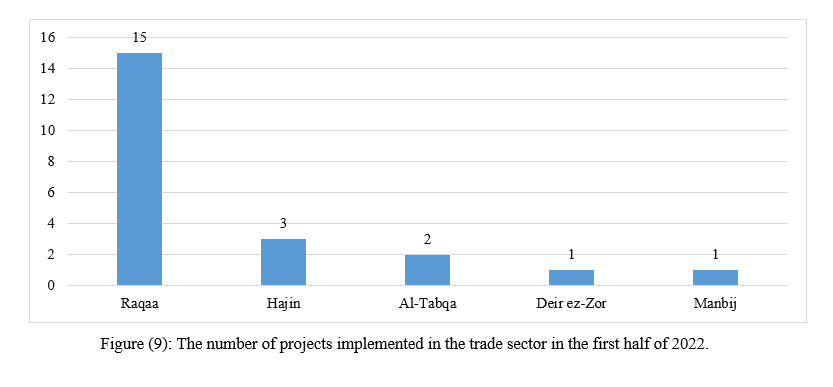 Agriculture and Livestock
Agriculture and Livestock
The agriculture and livestock sector had its share of the development plan, with a total of 18 projects completed. Deir ez-Zor came first with four, followed by al-Busayrah, al-Suwar, and al-Qamishli, with two projects each. The most important projects were establishing two farms of cypress and pine trees in the Mazkaft Dam Reserve, planting 3000 trees in each one, and supporting the camel, poultry, and livestock ranchers.
Until July, the Economics and Agriculture Board reported receiving about 360 thousand tons of wheat in Northeastern Syria and distributed 647,000 tons of fertilizer to farmers in Amuda.
During 2020-2021, landowners and farmers experienced great losses due to the high costs of fuel and fertilizers, drought, and high production costs. The corruption in the agricultural sector is linked to the illegal access that some individuals in the “Administration” have to subsidized water and farming materials, which forced many farmers to give up their lands to those with the most influence.
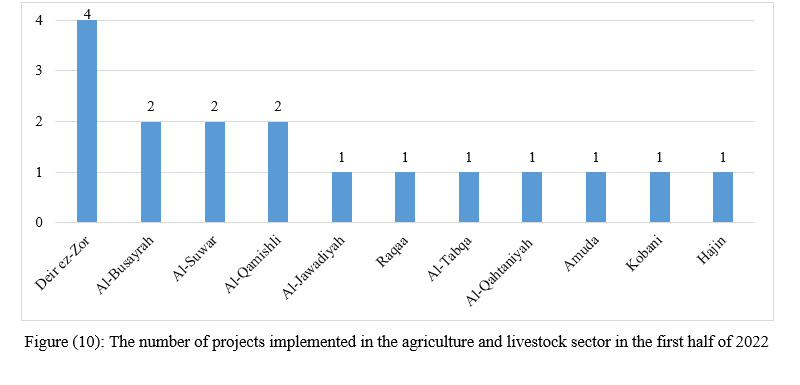 Finance Sector
Finance Sector
Four projects took place in al-Busayrah, Raqqa, and Deir ez-Zor. Supporting small and medium-sized enterprises and people with special needs.
And lastly 3 projects took place in the Industrial sector which are:
- Constructing a hose factory in al-Tabqa
- Starting a filling oxygen cylinders unit for hospitals and dispensaries in al-Qamishli
- Starting a plant for bottling drinking water in Amuda.
Administrative Decisions and Instructions
Several important decisions were made during the monitoring process including the following points:
- Preventing the wheat transfer within the administration's regions except by an official letter
- Setting the prices of wheat at 2.200 SYP/Kg, the ice block at 2000 SYP.
- Setting the price of an ampere of electricity by generators at 4000 SYP for subscribers of 6 amperes or less— generators running time is from 4 pm to 12 pm
- Adjusting the price of Russian phosphate fertilizer to $700/ton and nitrogen fertilizer to $730/ton by the Agricultural Society Development Company
- Obliging drivers to abide by the price set at 300 SYP within al-Qamishli
- Granting 100,000 SYP to every employee in the “Administration”
- Suspending the allocations of al-Baghouz and al-Shaab bakeries due to complaints
- Establishing a 25,000 SYP fine for anyone who violates the public hygiene rules (the Directorate of Environment in the al-Jazeera region)
- Specifying the amount of household diesel at 300 liters per month/ 150 SYP per liter (the Fuel Committee)
III. Concluding Analysis: Structural Inadequacy
The monitoring of the AANES region during the first half of 2022 indicated the following:
- Despite the completion of 358 projects in total and 148 projects in the water and sanitation sector, there is still an intractable crisis in ensuring drinking water to the residents of al-Hasakah city, with the lack of agreement or arrangements with the opposition factions in Ras al-Ayn.
- The decision to set a subsidized price only for registered cars encouraged the activity of the black market in which fuels are priced at five to ten times the regular market rate. Also, signing the oil refining and supply contracts with ‘specific people’ created a state of monopoly that had a negative impact on all sectors and citizens.
- The electricity sector suffers from crises that have forced people to rely on generators and amperes, not to mention the administration's unjustified cutting of the diesel supply.
- In the trade sector, the war elites and the influential people's control over the import and distribution of building materials may, over time, weaken the commercial structure and spread corruption.
- As for the agricultural sector, the weakness is apparent due to the lack of support for farmers and livestock ranchers, the spread of nepotism, and the intervention in distributing subsidized materials. It is noteworthy that the AANES region enjoys the most important strategic crops, such as wheat and cotton, and covers 43% of the total arable land of Syria (except for the Ayn al-Arab region).
- The administration's lack of financial defenses against crises imported from the regime's area, such as inflation, indicates weak governance in the financial sector and economic management. The absence of indicators and economic data was also one of the challenges that faced the monitoring and forecasting processes.
Based on the analyzed data, it can be concluded that the quality and the size of implemented projects and works in the AANES region indicate a structural inadequacy in the socio-economic model followed. Moreover, the AANES's various institutions and offices dealing with economic affairs did not contribute to the region's recovery or stability— despite controlling approximately 55% of the resources of Syria's GDP.
([1]) Original paper published on October 20, 2022, in Arabic,https://bit.ly/3T4S7IS

